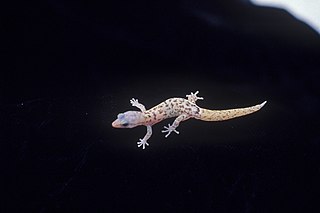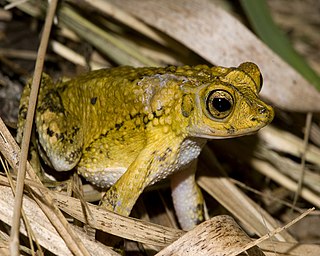
The Puerto Rican nightjar or Puerto Rican Whip-poor-will is a bird in the nightjar family found in the coastal dry scrub forests in localized areas of southwestern Puerto Rico. It was described in 1916 from bones found in a cave in north central Puerto Rico and a single skin specimen from 1888, and was considered extinct until observed in the wild in 1961. The current population is estimated as 1,400-2,000 mature birds. The species is currently classified as Endangered due to pressures from habitat loss.

The Monito gecko is a lizard, a species of gecko endemic to the island of Monito, in the archipelago of Puerto Rico.

The Puerto Rican crested toad, or simply Puerto Rican toad, is a species of toad found only in Puerto Rico and the Virgin Islands. It is the only species of toad native to Puerto Rico and the Virgin Islands. The species formerly occurred in Virgin Gorda and along the southern and northern karst in Puerto Rico. It is listed as a threatened by the US Fish and Wildlife Service due to habitat loss and introduced species. At one period of time it was believed to be extinct until it was rediscovered in 1966. The IUCN has the species listed as critically endangered.

The fauna of Puerto Rico is similar to other island archipelago faunas, with high endemism, and low, skewed taxonomic diversity. Bats are the only extant native terrestrial mammals in Puerto Rico. All other terrestrial mammals in the area were introduced by humans, and include species such as cats, goats, sheep, the small Asian mongoose, and escaped monkeys. Marine mammals include dolphins, manatees, and whales. Of the 349 bird species, about 120 breed in the archipelago, and 47.5% are accidental or rare.

Varronia rupicola, synonym Cordia rupicola, commonly known as the Puerto Rico manjack, is a critically endangered species of flowering shrub in the borage family, Boraginaceae, that is native to the islands of Puerto Rico and Anegada.

The Antillean fruit-eating bat is one of two leaf-nosed bat species belonging to the genus Brachyphylla. The species occurs in the Caribbean from Puerto Rico to St. Vincent and Barbados. Fossil specimens have also been recorded from New Providence, Bahamas.

Eneida's coquí is a species of coquí, a small variety of frog endemic to the main island of Puerto Rico and its archipelago. Known as coquí de Eneida in Puerto Rico, this amphibian is mainly terrestrial. Its average adult size is from 1.0 to 1.2 inches. It has a number of small warts located across its back and eyelids. Its main color is a light tone of greenish or grayish brown with a yellow tint on its underbelly. They often have a pair of light colored concave lines located on their backs. Their eyes are golden or green colored, generally dark colored with black venal reticulation. Its habitat is located in mountains that are 1,000 to 3,000 feet above sea level. This species seems to have suffered a population reduction, in the process disappearing from areas formerly considered its natural habitat. The reason behind this reduction is under study, and Eneida's coquí has been designated an endangered species until the cause is discovered. This population decrease is not considered to be linked with the loss of its habitat, which has prevented the protection of its habitat.

Libidibia monosperma is a species of legume in the family Fabaceae, with the common names cóbana negra and cóbana polisandro. It is found in the Dominican Republic, Puerto Rico, and Virgin Islands, U.S.. It is a federally listed threatened species of the United States.

The red-eyed coqui, churi, coqui churi, or coqui de las Antillas is a species of frog in the family Eleutherodactylidae that is found in Puerto Rico, the British and U.S. Virgin Islands, and introduced to Panama. Although there are many similar species that are endemic to these tropical locations, its unique physical, habitual, and behavioral characteristics distinguish it from other members of the genus Eleutherodactylus. This genus contains around 185 species that are located in the southern United States, Central America, South America, and the Caribbean, with 16 different species endemic to Puerto Rico. The red-eyed coqui was not brought into Panama City from its native habitats until the late 1960s. There it became established in urban parks before it began to colonize outside the city in the 1980s. In Puerto Rico, the largest island inhabited by the red-eyed coqui, it is found up to 1,200 meters above sea level. It is often compared to the common coqui, Puerto Rico's unofficial territorial symbol, but upon a closer ecological look, the red-eyed coqui has many differences.

Goetzea elegans, (also called beautiful goetzea, mata buey, or matabuey, is a species of plant in the Solanaceae or nightshade family of flowering plants. It is endemic to Puerto Rico. Today it is limited to the northwestern corner of the island because of deforestation and other consumption of its habitat for human use. It is federally listed as an endangered species in the United States.
Maytenus cymosa, also called Caribbean mayten, is a species of plant in the family Celastraceae. It is found in Puerto Rico, the British Virgin Islands, and the U.S. Virgin Islands.
Xylosma capillipes is a species of plant in the Salicaceae family. It is endemic to New Caledonia.

Xylosma crenata, the sawtooth logwood, is a species of flowering plant in the willow family, Salicaceae, that is endemic to the island of Kauaʻi in Hawaii. It is a tree, reaching a height of 46 ft (14 m). Sawtooth logwood inhabits montane mesic forests dominated by koa and ʻōhiʻa lehua at elevations of 975–1,065 m (3,199–3,494 ft). It is threatened by habitat loss.
Xylosma fawcettii is a species of plant in the Salicaceae family. It is endemic to Jamaica.
Xylosma latifolium is a species of plant in the Salicaceae family. It is native to Karnataka and Kerala in India.
Xylosma peltatum is a species of plant in the Salicaceae family. It is endemic to New Caledonia.
Xylosma pininsulare is a species of plant in the Salicaceae family. It is endemic to New Caledonia.

Sphaerodactylus macrolepis, also known as the big-scaled least gecko, big-scaled dwarf gecko, or cotton ginner, is a gecko distributed in the United States Virgin Islands and the British Virgin Islands and Culebra, Puerto Rico in the Caribbean. It is one of over 100 species in the genus Sphaerodactylus.
Ilex urbaniana, known commonly as the Urban's holly, is a species of tree or shrub in the Aquifoliaceae or holly family of flowering plants. It is found on Hispaniola, Puerto Rico, and the U.S. and British Virgin Islands.












